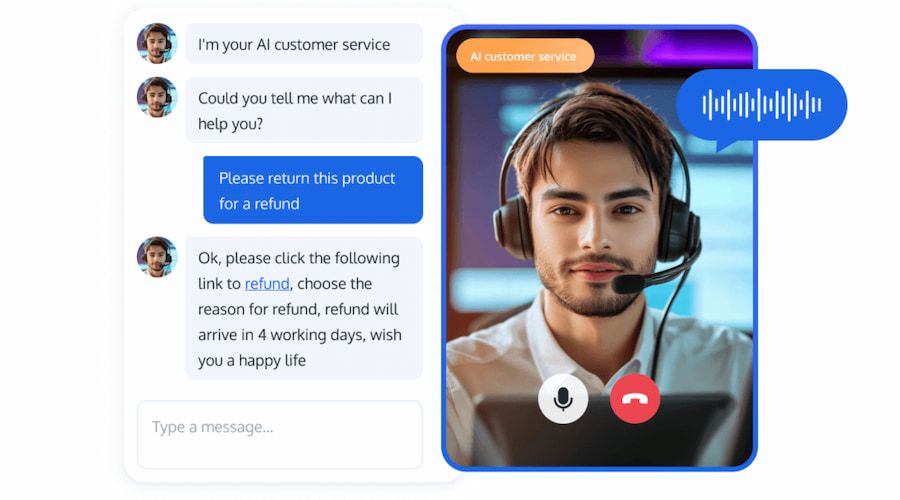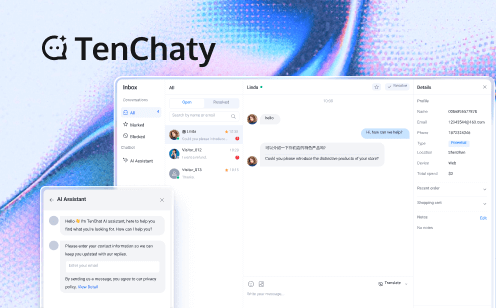 Conversational AI for Customer Service: How It Works & Why You Need It
Conversational AI for Customer Service: How It Works & Why You Need It
The adoption of conversational AI for customer service is skyrocketing—and it’s easy to see why. No one likes waiting on hold, repeating their issue to multiple agents, or getting stuck in support limbo. Whether you’re handling a flood of FAQs, offering 24/7 support, or trying to boost customer satisfaction, conversational AI can do a lot of the heavy lifting.
In fact, research from Grand View Research estimates that the global chatbot market alone will reach $27.3 billion by 2030, fueled by businesses seeking smarter, more automated customer interactions. Want to learn more? In this guide, we’ll break down what conversational AI is, how it works, why it matters, and how you can find the right solution to support your team—and your customers.
What Is Conversational AI?
Conversational AI refers to technologies that enable machines to understand, process, and respond to human language in a natural, conversational way. It’s the backbone of chatbots, virtual assistants, and voice-powered applications that you interact with on websites, apps, and smart devices.
At its core, conversational AI is designed to simulate a real conversation—whether it’s answering a simple question, guiding a user through a process, or helping troubleshoot a problem. Unlike basic rule-based chatbots that follow scripted flows, conversational AI uses advanced technologies like natural language processing (NLP) and machine learning (ML) to understand intent, context, and tone.
This means the AI doesn’t just match keywords—it actually “gets” what the customer is trying to say, allowing for more helpful, human-like responses. The more it interacts with users, the smarter and more accurate it becomes over time.
How does Conversational AI work?
At its core, conversational AI integrates several advanced technologies to facilitate effective communication between humans and machines:
- Natural Language Processing (NLP): This is where it all starts. NLP helps the system break down and understand what the user is saying—whether it’s spoken or typed. It includes Natural Language Understanding (NLU), which identifies the intent behind a message and extracts key information, and Natural Language Generation (NLG), which creates a natural, human-like response based on that understanding.
- Machine Learning (ML): Conversational AI systems utilize ML algorithms to learn from extensive datasets, identifying patterns and improving response accuracy over time. This continuous learning process enables the system to adapt to new phrases, slang, and evolving language nuances.
- Dialogue Management: This component manages the flow of conversation, maintaining context across multiple exchanges and determining the appropriate responses based on user input and conversation history.
- Integration with External Systems: To provide comprehensive responses, conversational AI often interfaces with databases, APIs, and other enterprise systems, retrieving real-time information pertinent to user queries.
The interaction process typically follows these steps:
- Input Processing: The system receives user input via text or speech. Speech inputs are transcribed into text using automatic speech recognition (ASR) technologies.
- Input Analysis: NLP and ML work together to interpret the message, determine intent, and extract relevant data.
- Response Generation: Based on the analysis, NLG builds a human-like response, drawing on dialogue history and any connected systems if needed.
- Output Delivery: The generated response is conveyed back to the user, either as text or synthesized speech through text-to-speech (TTS) systems.
Through these mechanisms, conversational AI enables machines to engage in meaningful and contextually relevant dialogues with users, enhancing interactions across various applications.
Benefits of Conversational AI for Customer Service
Adopting conversational AI for customer service can create real, measurable improvements for your business and your customers. Here are some of the biggest benefits:
24/7 Availability
Your customers don’t stop needing help after business hours. Conversational AI allows you to offer round-the-clock support without hiring an overnight team. Whether it’s answering FAQs or handling basic requests, AI can keep things running even while your human agents are offline.
Faster Response Times
Nobody likes waiting. With conversational AI, customers get instant responses—no queues, no hold music. This can significantly boost customer satisfaction, especially for high-volume inquiries that don’t need a human touch.
Consistent and Accurate Answers
AI doesn’t forget your policies or get tired after a long shift. It provides consistent, up-to-date answers every time, helping reduce confusion and ensuring customers always receive the correct information.
Reduced Workload for Support Teams
By handling routine or repetitive tasks—like tracking orders, resetting passwords, or answering “how do I…” questions—conversational AI frees up your human agents to focus on more complex, high-value conversations.
Cost Efficiency
Once set up, conversational AI can handle thousands of interactions simultaneously at a fraction of the cost of scaling a human team. This makes it a smart investment for businesses looking to grow without ballooning support costs.
Personalized Customer Experiences
When integrated with your CRM or backend systems, AI can personalize conversations based on customer history, preferences, or behavior—making interactions feel more tailored and relevant.
Increased Customer Engagement & Sales
AI chatbots help boost sales by engaging website visitors, offering personalized recommendations, and assisting in the buying process. In some industries, chatbots have increased conversion rates by up to 70%.
Seamless Multilingual Support
With multi-language capabilities, AI ensures customers receive accurate assistance without language barriers, expanding business reach to a global audience.
Use Cases & Examples of Conversational AI in Customer Service
Now that we’ve covered the benefits, let’s take a look at how conversational AI for customer service is being used in the real world across different industries:
- E-commerce: AI chatbots help customers find products, check order status, handle returns, and answer questions about shipping and sizing—instantly. For example, an online clothing store might use a chatbot to recommend outfits based on a customer’s style preferences and previous purchases.
- Banking & Finance: Conversational AI helps users check account balances, report lost cards, understand transactions, or get loan information without waiting on hold. A virtual assistant can also guide users through more complex processes like setting up auto-pay or applying for a credit card.
- Healthcare: Patients can use AI assistants to book appointments, get prescription reminders, or ask basic health-related questions. For instance, a healthcare provider might use conversational AI to pre-screen patients before their visit or provide post-visit follow-up.
- Travel & Hospitality: From booking flights to modifying hotel reservations, conversational AI can handle a range of customer interactions. A travel company might deploy a chatbot to offer itinerary suggestions, provide weather updates, or help rebook missed connections.
- Telecommunications: Telcos use AI to troubleshoot service issues, guide users through device setup, or help them upgrade their plans.
- SaaS & Tech Support: Conversational AI can walk users through product features, answer technical questions, or escalate tickets to human agents when needed. A SaaS company might use AI to onboard new users or provide in-app assistance in real time.

How to Choose the Best Conversational AI Chatbot Software for Customer Service
Selecting the best AI chatbot software for customer service ensures you maximize its benefits. Here are the key factors to consider:
Ease of Use
You don’t want to spend weeks or months learning how to use the software. Choose a chatbot that’s easy to implement and manage. Look for:
- A user-friendly interface that doesn’t require coding skills to create or manage conversations
- Drag-and-drop features for building workflows
- Templates for common use cases (e.g., appointment scheduling, order tracking, etc.)
The easier it is to build and maintain, the faster you can deploy your chatbot and see results.
Customization & Flexibility
Every business is unique, so your chatbot needs to reflect your specific brand voice and workflows. Choose a solution that offers robust customization options—whether that’s tweaking the chatbot’s tone, integrating with your CRM, or customizing response flows based on customer segments or departments.
Natural Language Understanding (NLU) Capabilities
A strong NLU engine ensures that the AI can understand and respond accurately to customer inputs, even when the language is complex or ambiguous. Be sure the chatbot software you select uses advanced NLP and machine learning to constantly improve its accuracy over time.
Omnichannel Support
Your customers interact with your brand across multiple platforms—websites, mobile apps, social media, and more. A good conversational AI platform should provide omnichannel support, ensuring that your chatbot can seamlessly work across these channels, maintaining consistent conversations regardless of where customers engage with your brand.
Multilingual Support
Ensure the chatbot can handle multiple languages, enabling global customer support across various communication channels.
Integrations with Existing Systems
Your chatbot needs to integrate seamlessly with your existing systems. Whether it’s your CRM, ticketing software, knowledge base, or live chat platform, the best AI chatbot software will connect with the tools you already use. Look for:
- API access for easy integrations
- Pre-built integrations with popular platforms (e.g., Salesforce)
- Support for connecting with multiple data sources to provide personalized, real-time responses
Scalability
As your business grows, your chatbot needs to scale with you. Choose software that can handle an increasing number of interactions, more complex workflows, and new functionalities without performance issues or added costs. This is especially important if you expect your customer support needs to grow significantly over time.
AI Training & Learning Capabilities
A successful conversational AI system should be able to continuously improve based on customer interactions. Look for software that allows the system to learn from past conversations, analyze user behavior, and optimize responses for better performance over time.
Analytics & Reporting Features
To gauge the effectiveness of your chatbot, you’ll need access to robust analytics. Look for software that provides detailed insights into chatbot performance, customer satisfaction, common issues, and response accuracy. This will help you identify areas for improvement and ensure that the chatbot is meeting your goals.
Security & Compliance
Your customers trust you with sensitive information. Ensure that the chatbot software you choose complies with relevant data protection regulations (such as GDPR, CCPA, or HIPAA) and has strong security features in place to protect customer data.
Cost vs. Value
A completely conversational AI for customer service free tool is not easy to find. Many are freemium options. Test with their free trials and choose a solution that provides a good balance between cost and the features you need to meet your customer service goals. Keep in mind that while some platforms may seem inexpensive upfront, they might lack the scalability or integrations needed to support long-term growth.
Why TRTC’s Conversational AI Solution is Ideal for Customer Service
If you’re looking to elevate your customer service interactions with cutting-edge conversational AI, look no further than TRTC’s conversational AI solution. Developed by Tencent Cloud, TRTC provides a powerful set of low-latency, high-quality messaging, audio/video communication, and AI services that are ideal for a range of real-time applications—making it a perfect choice for businesses looking to offer enhanced, AI-powered customer service.
Key Features of TRTC’s Conversational AI Solution for Customer Service
- Ultra-low Latency: One of the biggest challenges in providing a seamless customer experience is minimizing lag. TRTC ensures global audio/video transmission under 300 ms and conversation latency under 1,000 ms—matching the speed of natural human responses. This means smoother, more natural conversations that will keep your customers satisfied and engaged, without the frustration of delays.
- Efficient Deployment: TRTC’s code-free Playground allows you to quickly test and validate your AI solution, while its complete SDKs and APIs enable rapid integration, typically within 2-3 days. This means less downtime, lower development costs, and a faster path to improved customer support.
- Leading Audio Processing: With advanced AI noise suppression and 3A echo cancellation, TRTC ensures high-quality, precise speech recognition for AI-driven dialogues, improving call quality across a wide range of communication scenarios.
- Human-like Natural Conversations: TRTC’s solution supports voice activity detection (VAD), making interactions feel more like a real conversation by ensuring intelligent interruption, minimal lag, and fast response times. It mimics human-like dialogue rhythm, enhancing customer engagement.
- Multimodal AI Interaction: With the ability to handle text, voice, video, and digital avatars, TRTC supports multimodal communication, allowing your business to engage customers across different mediums for a more interactive and dynamic experience.
- Global Network Coverage: Available in over 200 countries and regions, TRTC’s solution ensures ultra-low latency and high-quality audio and video, even in weak network conditions, making it suitable for businesses with a global reach.
- Privacy and Security: With advanced data encryption and privacy protection technologies, TRTC ensures that customer conversations are kept secure and compliant with global privacy regulations, so you can confidently handle sensitive customer information.
By choosing TRTC, you’re investing in a solution that offers not just a chatbot, but a comprehensive communication system designed to support real-time, human-like interactions that build stronger customer relationships!
Conclusion
Customer expectations aren’t what they used to be—they want quick answers, helpful conversations, and zero hassle. That’s where conversational AI for customer service really shines. It helps you stay available 24/7, reduce response times, and deliver a better experience without overloading your team. By understanding how conversational AI works and where it fits into your customer support strategy, you’re already one step ahead. And when you choose the right chatbot software, you set your business up to scale smarter and serve better. So, whether you’re just getting started or ready to level up, now’s the perfect time to put AI to work for you—and your customers.
FAQs
What is conversational AI for customer service?
Conversational AI for customer service refers to the use of artificial intelligence technologies like natural language processing (NLP) and machine learning to enable automated, human-like interactions between customers and businesses. This includes chatbots, virtual assistants, and interactive voice response (IVR) systems that can handle inquiries, provide 24/7 support, and solve problems through text or voice.
Can you use AI for customer service?
Yes, AI can automate responses, assist human agents, and improve customer service efficiency by handling routine inquiries, reducing wait times, and offering 24/7 support.
What is the best AI for customer service?
The best AI for customer service depends on your business needs, but top options include Zendesk, Freshdesk, Intercom, Tidio’s Lyro, and CloudTalk. These tools offer features like AI chatbots, ticket automation, real-time support, and analytics to improve customer experience.
Can I use ChatGPT for customer service?
Yes, you can use ChatGPT for customer service to automate responses, handle FAQs, and provide 24/7 support. It can be integrated with CRM systems to personalize replies, assist with tasks like order tracking or password resets, and escalate complex issues to human agents when needed. To get started, you’ll need to integrate ChatGPT with your website, app, or support platform.


